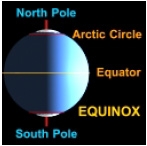The Earth and Sun - Latitude and Longitude

The planet Earth is part of the Solar system with the Sun at the center. There are other planets in the solar system. Mercury and Venus are closer to the Sun, and Mars, Jupiter, Saturn, Uranus, Neptune, and Pluto are farther away. The planets revolve around the Sun. Smaller bodies called moons revolve around the planets. The earth has one Moon. The earth’s solar system is part of a Galaxy consisting of millions of other solar systems with their own suns. There are billions of other galaxies called stars. The galaxies make up the Universe.
The farthest known galaxy is about 15 billion light-years from the earth. A light-year is the distance that light travels in one year. A year consists of 365.25 days; a day is 24 hours, an hour is 60 minutes, and a minute is 60 seconds. So there are 31,557,600 seconds (31.5576 million seconds) in a year. Light travels at 186,000,000 (186 million) miles per second. So the distance of the farthest galaxy is 5,870,000,000,000,000 miles from the earth.
All this is irrelevant and the only body that that has any significant impact on the earth is the earth's own moon. The gravitational pull between the earth and the moon affects the weather and the tides of the seas and oceans on the earth. The moon completes a full cycle from an apparent new moon (to viewers on earth) to full moon in 28 days. This is the basis of the week which consists of seven days and it is also, to some extent the month, which varies from 28 days to 31 days. The basis of today's internationally accepted calendar is that the earth revolves around the sun in 365.25 days (divided into 12 months) and the earth rotates about it's own axis in 24 hours.
The equatorial diameter of the earth is 8,000 (7,926) miles and the circumference around the earth is 25,000 (24,830) miles. The earth is surrounded by atmospheric air up to about 100 miles deep, but most of the mass of air is within 10 miles from the earth’s surface. The distance of the earth from the sun is 93 million (93,000,000) miles. The sun is a mixture of gases at approximately 11,000 (10,832) degrees Fahrenheit (6,000 degrees Celsius). The sun is one of the stars in the galaxy. Without the heat energy from the sun there would be no life on earth. In fact, it has not been proved that there is life anywhere else in the universe.
Establishing a Location on Earth
Latitude: The shape and surface of the earth is a sphere or globe. Horizontal measurement and locations up and down the surface of the earth from the equatorial centerline circumference consists of Latitudes. There are 90 degrees North latitudes and 90 degrees South latitudes with the equator representing 0 degrees latitude.
Longitude: Vertical measurement around the global surface of the earth consists of Longitudes. The line passing from the northern point (North Pole) to the southern point (South Pole) and through Greenwich, London, United Kingdom was selected as 0 degrees longitude. The rest of the earth's surface was divided into 180 degrees East longitudes and 180 degrees West longitudes. Latitudes and Longitudes establish a coordinate point on the surface of the earth.
Altitude: However, the land surface on the earth can vary from -1000 feet (the Dead Sea) below sea level to about 30,000 feet (Mount Everest) above sea level. So a third coordinate, Elevation or Altitude has to be specified to establish a point on the surface of the earth. Longitude, Latitude and Altitude therefore corresponds to X,Y,Z coordinates.

| Vertical Section through | Horizontal Section through |
| 0o and 180o Longitude | 0o Latitude (Equator) |
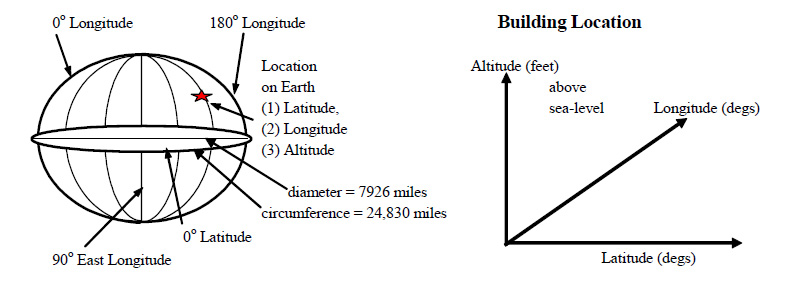
Figure
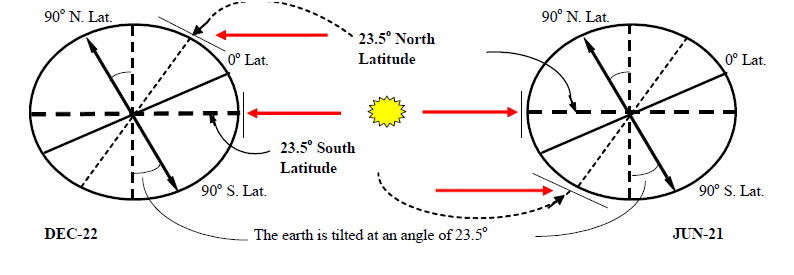
 Guide to the
Guide to the
EQUINOXES and SOLSTICES
SOLSTICE
 SUMMER SOLSTICE: The first day of the Season of Summer. On this day (JUNE 21 in the northern hemisphere*) the Sun is farthest north and the length of time between Sunrise and Sunset is the longest of the year.
SUMMER SOLSTICE: The first day of the Season of Summer. On this day (JUNE 21 in the northern hemisphere*) the Sun is farthest north and the length of time between Sunrise and Sunset is the longest of the year.
 WINTER SOLSTICE: The first day of the Season of Winter. On this day (DECEMBER 22 in the northern hemisphere*) the Sun is farthest south and the length of time between Sunrise and Sunset is the shortest of the year.
WINTER SOLSTICE: The first day of the Season of Winter. On this day (DECEMBER 22 in the northern hemisphere*) the Sun is farthest south and the length of time between Sunrise and Sunset is the shortest of the year.
* In the southern hemisphere, winter and summer solstices are exchanged. Summer: December 22. Winter: June 21.
EQUINOX
Two times of the year when night and day are about the same length. The Sun is crossing the Equator (an imaginary line around the middle of the Earth) and it is an equal distance from the North Pole and the South Pole.SPRING EQUINOX: The first day of the Season of Spring - and the beginning of a long period of sunlight at the Pole. In the northern hemisphere: MARCH 20 (the Sun crosses the Equator moving northward). In the southern hemisphere: SEPTEMBER 22 (the Sun crosses the Equator moving southward).
AUTUMN EQUINOX: The first day of the Season of Autumn - and the beginning of a long period of darkness at the Pole. In the northern hemisphere: SEPTEMBER 22 (the Sun crosses the Equator moving southward). In the southern hemisphere: MARCH 20 (the Sun crosses the Equator moving northward).
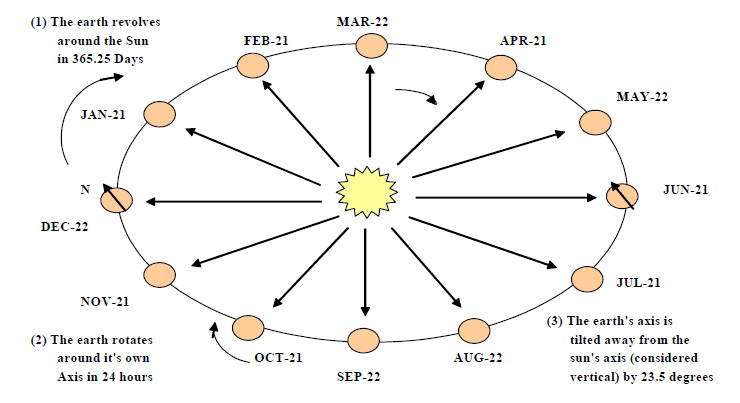
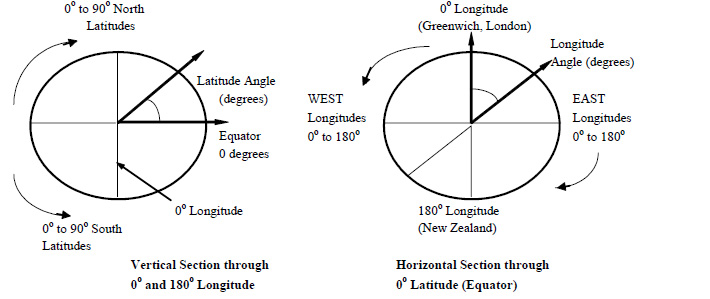
Figure
The path of the earth around the sun is slightly elliptical and varies by 3 million miles from it's average distance of 93 million miles. However this has little impact on the weather conditions on earth. Seasons occur because the earth's axis is tilted away from the sun by 23.5 degrees. As the earth revolves around the sun, the vertical perpendicular ray of the sun appears to move up and down from 23.5 degrees north latitude (Tropic of Cancer) on June 21 through 0 degrees latitude (Equator) on September 22 and March 21 to 23.5 degrees south latitude (Tropic of Capricorn) on December 22.
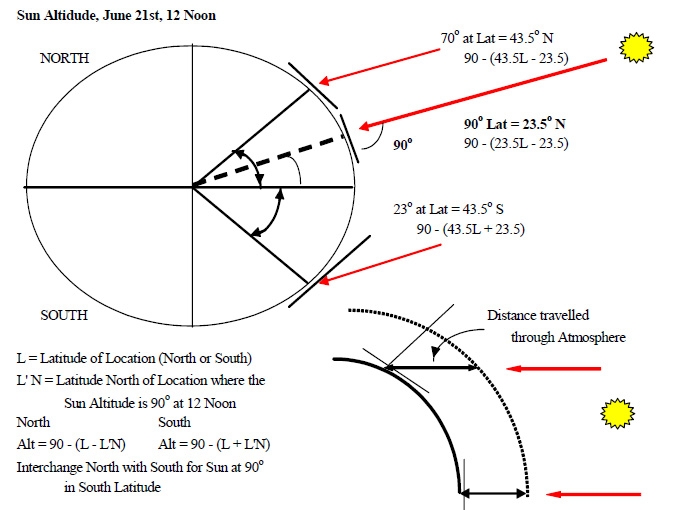
The Sun's Declination Angle

The latitude location where the sun's ray is perpendicular is called declination. Sun declination therefore varies from 23.5oN to 23.5oS. Seasons and weather conditions are also due to the fact that the earth is a sphere and therefore the angle at which the sun's ray strikes the surface of the earth decreases as the point location moves towards the North and South Poles.

Table

Time
Like all measurement time was established by convention. The time it takes for the earth to spin once on it’s axis is called a Day. The day was divided into 24 hours. Each hour was divided into 60 minutes and each minute into 60 seconds. Note that a Day is always 24 hours and Night is part of a day and refers to the time when the sun is not visible at a location and sheds no light on the location. However, sometimes the term day is used to refer to the time when it is not night. All solar radiation calculations are based on solar time where 12 Noon occurs when the sun altitude is at maximum height. Energy computer programs make this adjustment given the local longitude and local standard time and the results are adjusted to show actual radiation at the local time.

Time Zones.
Since people (not necessarily all other animals and birds) prefer to sleep at night and work during the day, the world is divided into Time Zones based on it's Longitude. Since the range of longitudes (east-west) that small countries fall into is about 10 to 20 degrees then it requires only one time zone. Most countries fall into this category. The distance from North to South (latitudes) of a country such as Chile in South America might be large but the distance from East to West (longitudes) is small. Latitude range affects the number of daylight hours. Countries such as the United States, Canada and Russia stretch over a wide range of longitudes. Regions in these countries are therefore divided into several time zones. Time Zones (TZ) in the US and Canada:


The Apparent Movement of the Sun
Although the sun's position is stationary and it is the earth that spins on it's axis every 24 hours and revolves around the sun in 365 days, at a given point location on the earth, the sun appears to move relative to that point which appears to be stationary. Measurements of the position of the moving sun relative to a fixed point location on earth is used in building sciences calculations.
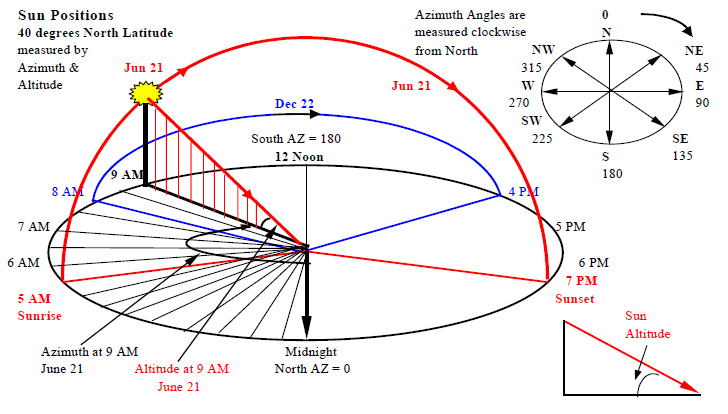
Figure

Apparent Sun Position (movement) on June 21 at 40 degrees North Latitude


Apparent Sun Position (movement) on December 22 at 40 degrees North Latitude


Figure
Sun Ray Component Perpendicular to Wall or Roof Surface
The azimuth angle of a building's exterior surface (wall or roof) is fixed and is measured clockwise from the North which is set as zero. The azimuth line of the sun is the horizontal projection of the sun's ray on the ground. The sun's azimuth angle varies with the hour of the day and the day of the year. A horizontal roof (tilt angle = 0o) has no azimuth angle. A tilted roof has the azimuth angle of the equivalent wall (lift the roof on it's hinge with the wall until it is vertical). The intensity of the sun's ray on a wall or roof is the component perpendicular to the surface.
Wall-Solar Azimuth is the positive value of the difference between the sun azimuth angle and the wall azimuth angle. The azimuth angle of a given wall is fixed and the sun azimuth angle varies. Consider a wall facing east with an azimuth angle of 90o and the two cases of sun azimuth angles of 45o and 135o. The wall-solar azimuth angles are (45 - 90 = -45) and (135 - 90 = 45).

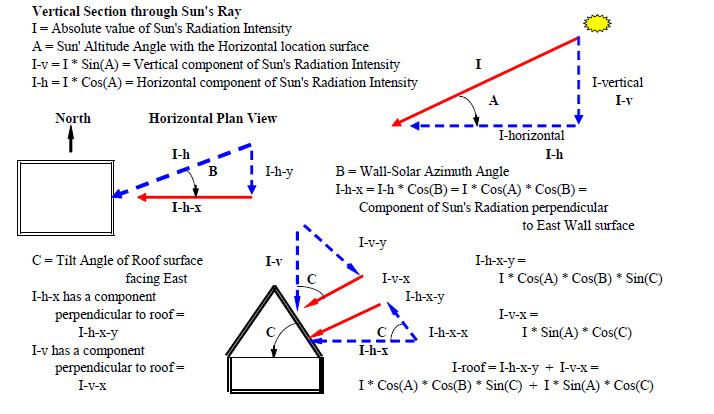
Figure

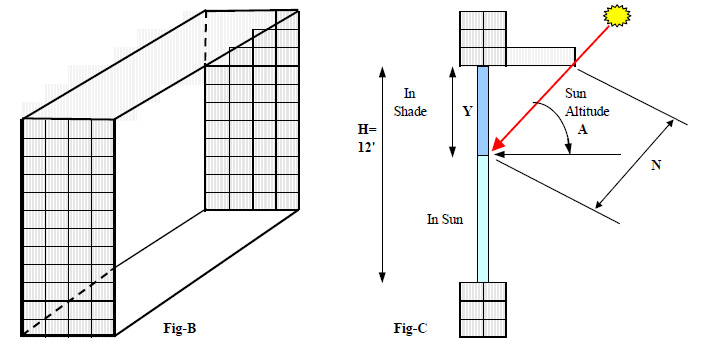
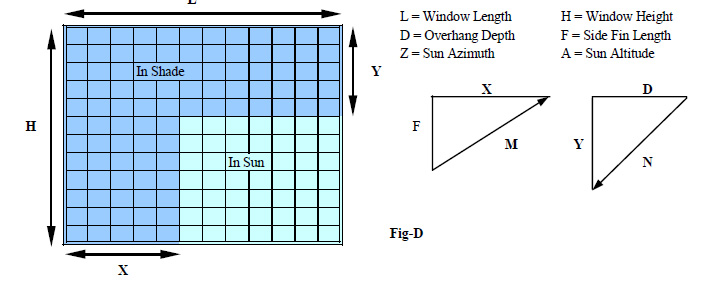
Solar Equations
Latitude (LAT) of a location is the angular displacement above or below the horizontal sectional plane of the Equator (0 degrees latitude) measured from the center of the earth.
Longitude (LON) is the angle made by the sectional plane through the location and North and South Poles (3 points) and the sectional plane through Greenwich, London UK.
Sun Declination Angle (DCL) is the latitude location where the sun's ray is perpendicular. Sun declination therefore varies from (+) 23.45oN to (-) 23.45oS.
The declination angle for any day of the year can be estimated by the following equation.
DCL = 23.45 * SIN [ 360 * (284 + N) / 365 ]
N = Day of Year ( 1 to 365)
Solar Hour Angle (HR) is the angular displacement of the sun from Longitude = 0o (Greenwich, London, UK). The earth rotates 360o around it's axis (there are 360 degrees of longitude lines) in 24 hours. So one hour = 360/24 = 15 degrees of longitude lines and one degree longitude = 60 minutes / 15 degrees = 4 minutes.
- HR = 15 * ( T - 12 + TZN ) - LON
- HR = Solar hour angle
- T = Local time hour ( 6 (6 AM), 12 (Noon), 17 (5 PM), etc.)
- TZN = Time Zone: Eastern = 5 (75o), Central = 6 (90o), Mountain = 7 (105o), Pacific = 8 (120o)
- LON = Longitude of location ( Chicago = 87o , Minneapolis = 90o ).
Sun Altitude Angle (ALT) at a location is the vertical angle made by the sun with the horizontal surface plane of the location at a given hour. Sun altitude reaches it's maximum value at solar 12 noon. Local time depends on the variance of the location longitude with the longitude on which the time zone is based. For example, time zone 6 is based on 90 degree longitude and Chicago is located on 87 degree longitude. So there is a 12 minute (3 degrees x 4 minutes per degree) difference between solar noon and Chicago noon. When Chicago switches to daylight savings time in summer (moves the clock forward 1 hour) then there is a 72 minute difference. Sun altitude at a location is a function of the location's latitude. The maximum value is 90 degrees and this can only occur between 23.45 N and 23.45 S latitudes
Sin(ALT) = Sin(DCL) * Sin(LAT) + Cos(DCL) * Cos(LAT) * Cos(HR)
Sunrise and sunset hours occur when the sun altitude is zero.
Sun Azimuth Angle (AZM) is the angle made by the horizontal component of the sun's direct ray with the North direction (azimuth = 0) at a location in the northern hemisphere. Sun azimuth is the angular displacement at a given hour (HR) measured clockwise from the north azimuth line.
Tan(AZM) = Sin(HR) / [ Sin(LAT) * Cos(HR) - Cos(LAT) * Tan(DCL) ]
At Noon the sun's azimuth angle coincides with the North-South line (ASHRAE = 0o , DOE = 180o ). The sun's altitude angle is = 90 - LAT + DCL
Solar Radiation Intensity (I) is the radiant heat intensity (quantity) per unit time (usually 1 hour) reaching the earth from the sun. It depends on the sun altitude (a) which in turn depends on the location latitude (L) and the time (T, h) of the year. There are accurate equations to determine sun radiation intensity. The following is an approximate method.
I = 234 * SQRT(Sin(LAT)) + 63
Solar Radiation (Energy)
The major obstacle to the use of solar energy in powering heating, cooling and other mechanical systems is economic. Some of the problems (see ASHRAE Fundamentals Handbook, CH.32) are:
(1) The amount of solar radiation reaching the earth is low in intensity, rarely exceeding 300 btu/hr.ft2. Consequently when large amounts are needed, large collectors must be used.
(2) It is intermittent because of the variation in solar intensity from zero at sunrise, to a maximum at noon, and back to zero at sunset.
(3) Solar energy is therefore not available at night and there has to be some means of storing the solar energy collected during the day for use at night.
(4) It is subject to unpredictable interruptions because of clouds, rain, snow, hail, dust and pollutants.
(5) The equipment needed to collect and store solar energy is high in cost. In most cases the lifecycle cost of the solar equipment is greater than the savings in fuel costs.
Solar Constant
Solar energy approaches the earth as electro-magnetic radiation with wavelengths ranging from 0.1 μm (X-rays) to 100 m (radio waves). Only a limited band need be considered in practical applications on earth. 99% of the suns radiant energy is between 0.28 μm and 4.96 μm.
The approximate value of the intensity of solar radiation on a surface normal to the sun's rays, just beyond the earth's atmosphere, at the average distance (about 93 million miles) between the sun and the earth is 433 btu/hr.ft2. This is called the solar constant. This radiation value is reduced as it crosses the earth's atmosphere and, as mentioned before, rarely exceeding 300 btu/hr.ft2.
Apparent Solar Time (AST)
AST = LST + ET + 4 * ( LST longitude – Local longitude )
ET = Equation of time (adjustment factor that varies with the day of the year)
(5) Latitude and Longitude
Any location on Earth is described by two numbers--its latitude and its longitude. If a pilot or a ship's captain wants to specify position on a map, these are the "coordinates" they would use.
Actually, these are two angles, measured in degrees, "minutes of arc" and "seconds of arc." These are denoted by the symbols ( o, ', " ) e.g. 35o 43' 9" means an angle of 35 degrees, 43 minutes and 9 seconds (do not confuse this with the notation (', ") for feet and inches!). A degree contains 60 minutes of arc and a minute contains 60 seconds of arc--and you may omit the words "of arc" where the context makes it absolutely clear that these are not units of time.
Calculations often represent angles by small letters of the Greek alphabet, and that way latitude will be represented by λ (lambda, Greek L), and longitude by φ (phi, Greek F). Here is how they are defined.

Latitude
Imagine the Earth was a transparent sphere (actually the shape is slightly oval; because of the Earth's rotation, its equator bulges out a little). Through the transparent Earth (drawing) we can see its equatorial plane, and its middle the point is O, the center of the Earth.
To specify the latitude of some point P on the surface, draw the radius OP to that point. Then the elevation angle of that point above the equator is its latitude λ--northern latitude if north of the equator, southern (or negative) latitude if south of it.
[How can one define the angle between a line and a plane, you may well ask? After all, angles are usually measured between two lines!
Good question. We must use the angle which completes it to 90 degrees, the one between the given line and one perpendicular to the plane. Here that would be the angle (90o- λ) between OP and the Earth's axis, known as the co-latitude of P.]
What that value is depends of course on where we begin to count--on where zero longitude is. For historical reasons, the meridian passing the old Royal Astronomical Observatory in Greenwich, England, is the one chosen as zero longitude. Located at the eastern edge of London, the British capital, the observatory is now a public museum and a brass band stretching across its yard marks the "prime meridian." Tourists often get photographed as they straddle it--one foot in the eastern hemisphere of the Earth, the other in the western hemisphere.
A lines of longitude is also called a meridian, derived from the Latin, from meri, a variation of "medius" which denotes "middle", and diem, meaning "day." The word once meant "noon", and times of the day before noon were known as "ante meridian", while times after it were "post meridian." Today's abbreviations a.m. and p.m. come from these terms, and the Sun at noon was said to be "passing meridian". All points on the same line of longitude experienced noon (and any other hour) at the same time and were therefore said to be on the same "meridian line", which became "meridian" for short.
About time--Local and Universal
Two important concepts, related to latitude and (especially) longitude are Local time (LT) and Universal time (UT)
Local time is actually a measure of the position of the Sun relative to a locality. At 12 noon local time the Sun passes to the south and is furthest from the horizon (northern hemisphere). Somewhere around 6 am it rises, and around 6 pm it sets. Local time is what you and I use to regulate our lives locally, our work times, meals and sleep-times.
But suppose we wanted to time an astronomical event--e.g. the time when the 1987 supernova was first detected. For that we need a single agreed-on clock, marking time world-wide, not tied to our locality. That is universal time (UT), which can be defined (with some slight imprecision, no concern here) as the local time in Greenwich, England, at the zero meridian.
Local Time (LT) and Time Zones
Longitudes are measured from zero to 180o east and 180o west (or -180o), and both 180-degree longitudes share the same line, in the middle of the Pacific Ocean.
As the Earth rotates around its axis, at any moment one line of longitude--"the noon meridian"--faces the Sun, and at that moment, it will be noon everywhere on it. After 24 hours the Earth has undergone a full rotation with respect to the Sun, and the same meridian again faces noon. Thus each hour the Earth rotates by 360/24 = 15 degrees
When at your location the time is 12 noon, 15o to the east the time is 1 p.m., for that is the meridian which faced the Sun an hour ago. On the other hand, 15o to the west the time is 11 a.m., for in an hour's time, that meridian will face the Sun and experience noon.
In the middle of the 19th century, each community across the US defined in this manner its own local time, by which the Sun, on the average, reached the farthest point from the horizon (for that day) at 12 oclock. However, travelers crossing the US by train had to re-adjust their watches at every city, and long distance telegraph operators had to coordinate their times. This confusion led railroad companies to adopt time zones, broad strips (about 15o wide) which observed the same local time, differing by 1 hour from neighboring zones, and the system was adopted by the nation as a whole.
The continental US has 4 main time zones--eastern, central, mountain and western, plus several more for Alaska, the Aleut islands and Hawaii. Canadian provinces east of Maine observe Atlantic time; you may find those zones outlined in your telephone book, on the map giving area codes. Other countries of the world have their own time zones; only Saudi Arabia uses local times, because of religious considerations.
In addition, the clock is generally shifted one hour forward between April and October. This "daylight saving time" allows people to take advantage of earlier sunrises, without shifting their working hours. By rising earlier and retiring sooner, you make better use of the sunlight of the early morning, and you can enjoy sunlight one hour longer in late afternoon.
The Date Line and Universal Time (UT)
Suppose it is noon where you are and you proceed west--and suppose you could travel instantly to wherever you wanted.
Fifteen degrees to the west the time is 11 a.m., 30 degrees to the west, 10 a.m., 45 degrees--9 a.m. and so on. Keeping this up, 180 degrees away one should reach midnight, and still further west, it is the previous day. This way, by the time we have covered 360 degrees and have come back to where we are, the time should be noon again--yesterday noon.
Hey--wait a minute! You cannot travel from today to the same time yesterday!
We got into trouble because longitude determines only the hour of the day--not the date, which is determined separately. To avoid the sort of problem encountered above, the international date line has been established--most of it following the 180th meridian--where by common agreement, whenever we cross it the date advances one day (going west) or goes back one day (going east).
That line passes the Bering Strait between Alaska and Siberia, which thus have different dates, but for most of its course it runs in mid-ocean and does not inconvenience any local time keeping.
Astronomers, astronauts and people dealing with satellite data may need a time schedule which is the same everywhere, not tied to a locality or time zone. The Greenwich mean time, the astronomical time at Greenwich (averaged over the year) is generally used here. It is sometimes called Universal Time (UT).
Right Ascension and Declination
The globe of the heavens resembles the globe of the Earth, and positions on it are marked in a similar way, by a network of meridians stretching from pole to pole and of lines of latitude perpendicular to them, circling the sky. To study some particular galaxy, an astronomer directes the telescope to its coordinates.
On Earth, the equator is divided into 360 degrees, with the zero meridian passing Greenwich and with the longitude angle λ measured east or west of Greenwich, depending on where the corresponding meridian meets the equator.
In the sky, the equator is also divided into 360 degrees, but the count begins at one of the two points where the equator cuts the ecliptic--the one which the Sun reaches around March 21. It is called the vernal equinox ("vernal" means related to spring) or sometimes the first point in Aries, because in ancient times, when first observed by the Greeks, it was in the zodiac constellation of Aries, the ram. It has since then moved, as is discussed in the later section on precession.
The celestial globe, however, uses terms and notations which differ somewhat from those of the globe of the Earth. Meridians are marked by the angle α (alpha, Greek A), called right ascension, not longitude. It is measured from the vernal equinox, but only eastward, and instead of going from 0 to 360 degrees, it is specified in hours and other divisions of time, each hour equal to 15 degrees.
Similarly, where on Earth latitude goes from 90o north to 90o south (or -90o), astronomers prefer the co-latitude, the angle from the polar axis,equal to 0o at the north pole, 90o on the equator, and 180o at the south pole. It is called declination and is denoted by the letter δ (delta, Greek small D). The two angles (α, δ), used in specifying (for instance) the position of a star are jointly called its celestial coordinates.
The next section tells how the stars, the Sun and accurate clocks allowed sailors to find their latitude and longitude.
